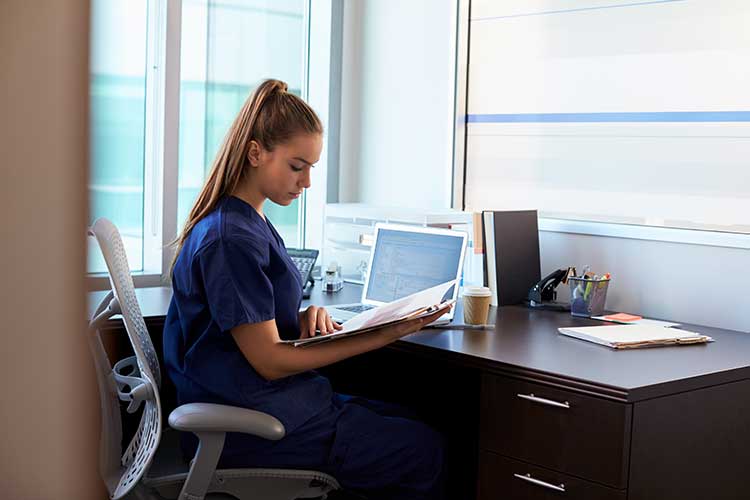How reliable are online educational resources for your continuing professional development (CPD) needs as a nurse or midwife?
Evidence-based practice is at the heart of everything you do as a health professional, and continuing professional development (CPD) is one way of ensuring that your skills are not only kept up-to-date, but are also based on the latest research findings.
A study by Katsikitis et al. (2013) found that although nurses valued ongoing learning and understood its importance, they had concerns.
Perceived barriers to completing CPD included understaffing, a belief that employers should share the responsibility of accessing the education, and that it could interfere with time outside of work. These are clearly serious concerns – a nurse working on an understaffed ward is unlikely to find an opportunity during work hours for additional training, particularly when their employer feels it’s the nurse’s responsibility to keep up-to-date.
So, what does that mean for the future of CPD for nurses and midwives?
It’s evident from the growing trend of online-based CPD providers, of which Ausmed is an example, that there is a shift away from traditional skills-based workshops and lectures to seminars, videos, podcasts and blogs.
Not only is it easier for you to access these online educational resources when it suits you, but it’s also easier for your employer to fit them in around your work pattern, too.

Free Open Access Medical Education (FOAM)
However, there is a potential pitfall with this online-based learning – credibility and reliability.
The difficulty lies with the fact that anyone can create a webpage within minutes. There are often no editorial boards to check standards and assure high quality – the information presented in what appears to be an objective way is often pure opinion or conjecture. This is particularly the case when the information presented comes from a sole author.
While there are tools and systems in place to help you appraise and evaluate literature, none have been developed for online educational resources so far. Not only does this mean that worthwhile online material is being ignored because the reader cannot determine credibility, chances are that poorly researched articles and papers are being referenced.
This has to be a concern for anyone wanting to ensure that evidence-based practice is at the forefront of what they do.
If You Can’t Assess the Quality of a Resource, How Likely Are You to Use it for Your CPD?
It is essential to critically appraise the information you come across online and determine the quality before including it in your studies.
So, how can you appraise these sources and judge them as reliable enough to inform your practice?
This was a question the team behind the 'METRIQ study' asked, as they aimed to 'derive a quality evaluation instrument for this purpose' (Chan et al. 2016). They felt that just as a critical appraisal of primary literature is essential for a robust medical education, so too is the need to evaluate secondary materials such as online sources. While you’ll have learned how to conduct a literature review as part of your university-based nurse training, chances are that you received little help with learning how to judge secondary sources.
The METRIQ research team used a three-phase method to create two quality evaluation tools for online educational resources: METRIQ-8 and METRIQ-5.
They found that these scoring systems gained comparable results to traditional gestalt evaluation methods. Further research into these systems is necessary before nurses can use them to evaluate their research sources. So, what can be learned from this study now?

There is a Definite Need for Nurses and Midwives to be Able to Appraise Sources Appropriately
Most health professionals don’t always have the skills to achieve this, or perhaps more importantly, the time.
There are some helpful questions you can ask yourself as you evaluate an online resource:
- Who owns the site and what is the purpose?
- What are the credentials of the author?
- How accurate is the information, and can it be verified?
- Are sources cited, and how reliable are they?
- How objective is it? Does it only present one viewpoint?
- How up-to-date is it? Are the statistics still relevant?
It’s always better to go to a reliable and credible website for up-to-date information - such as Ausmed.
Ausmed is the only Australian nurse education provider to gain accreditation from the American Nurses Credentialing Center’s Commission on Accreditation (ANCC). Essentially, this means that the Ausmed website and resources have gone through a rigorous testing process to ensure that they are of the highest quality, and professional standards have been met.
Always Check a CPD Provider for Accreditation
Ultimately, as with traditional sources, critical appraisal is necessary to evaluate the worth and effectiveness of online educational resources. Every health education provider requires the student and developing professional to learn how to critically appraise primary and secondary reference materials to form effective evidence-based practice. Unfortunately, the same level of attention to online sources has been scant, if not nonexistent.
One suggestion made by the METRIQ study team is that online educational resources will need a group approach to appraise and evaluate credibility and reliability. It could be argued that this is already taking place, in perhaps a more informal format, on social media sites by nurses themselves.
There are also accreditation schemes from governing and professional bodies around the world that are becoming increasingly important against the tide of open-access health opinion.
Whatever changes may happen in the future regarding source verification and research education, it is crucial that nurses and midwives take action today to ensure they are using the best resources possible for their continuing professional development.
Topics
References
- Chan, TM et al. 2016, ‘Derivation of Two Critical Appraisal Scores for Trainees to Evaluate Online Educational Resources: A METRIQ Study’, Western Journal of Emergency Medicine, vol. 17, no. 5, pp. 574–84, viewed 10 April 2017, http://doi.org/10.5811/westjem.2016.6.30825
- Katsikitis, M et al. 2013, ‘Continuing Professional Development in Nursing in Australia: Current Awareness, Practice and Future Directions’, Contemporary Nurse, vol. 45, no. 1, pp. 33-45, viewed 10 April 2017, https://www.ncbi.nlm.nih.gov/pubmed/24099224

